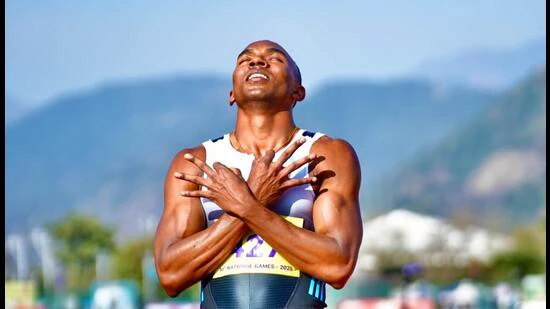New Delhi: Animesh Kujur is a confident young man. From his Lightning Bolt celebrations to proclamations, he oozes the kind of belief that is rarely seen among Indian athletes.
Kujur though lives in the fast lane. Not world standard fast, but quick enough to hold your attention.
Last weekend, the 22-year-old clocked a 100m national record of 10.18 seconds at the Dromia International Sprint and Relays meet in Vari, Greece. Running in the B Final, he edged out Greece’s Sotirios Garagganis (10.23secs) and Finland’s Samuli Samuelsson (10.28secs), at the World Athletics Continental Tour silver level meet. He bettered the national mark held by his relay teammate Gurindervir Singh (10.20secs). Gurindervir’s record lasted less than four months, a testimony to the competition and promise Indian men’s sprints hold.
Kujur though is not over the moon. “10.18secs is not that great a time,” he says. “It’s good, but not worth celebrating. I know I can do better. And I will do better this year itself. Aap dekhna (wait and see).”
The confidence stems from training and a realisation that he has the gift of genetics as well as speed. A bit of technical refinement, he is confident, will help get closer to running under 10 secs.
“Everyone keeps asking me about that. To go sub-10 and sub-20 (in 200m) are my ultimate goals, but it won’t happen overnight. Considering that I started competing only a few years back, I am sure I’ve the potential to do much better,” he says.
To realise his goal, however, a process needs to come to fruition, and for that Kujur has been camping in Magglingen Sportzentrum in Bern, Switzerland for close to two weeks. Training under Reliance Foundation coach Martin Owens and strength and bobsleigh performance coach Chris Woolley, Kujur has been honing his start to shave off those milliseconds.
“It’s been an amazing experience. The technical insights have been superb and I can feel the difference already,” he says.
Owens is also delighted. “We can certainly squeeze a couple of 100 (milliseconds) just by correcting his block position and angle of the block,” he says. The positioning of blocks depends on the length of an athlete’s limbs while the angle of the first and second blocks are considered optimum at 45 and 55 degrees respectively.
Woolley has introduced Kujur to many lower body routines for strengthening without compromising on flexibility. He figured that Kujur’s hamstring and lower back were not flexible enough, costing crucial momentum at the start.
“I spend a lot of time with Chris in the gym and he has been very patient with me. I don’t even know the names of some of the machines. The technology here is quite something,” Kujur says.
“If 10 days of training with him can make such a difference, imagine what a month will do,” adds Kujur, whose previous best 100m timing was 10. secs.
Kujur will next run in the U-23 section at the Monaco Diamond League (July 11) followed by Spitzen Leichtathletik in Lucerne, Switzerland (July 15). He will then leave for Germany on July 19 for the World University Games. In all these meets, he will compete only in the 200m.
“It is my pet event and I aim to better my mark,” says Kujur, whose 200m national record is 20.32 secs. He was part of the quartet that holds the 4x100m relay national record.
“I always knew I was the fastest man in India. Now I have the timing to show,” he says.
The secret of Kujur’s success, Owens says, lies in his mindset. “He doesn’t chase time or medals. He just wants to improve. He is what I call intrinsically motivated.”
The coach’s next step for Kujur is to get him to run the 200m in 20.16 secs, which would see him qualify for the Tokyo World Championships in September.
“We are working a lot on stuff – speed, endurance, top-end speed, curve running, running off the bend. He’s got a good training group as well. He has all the makings of a track superstar,” Owens adds.
